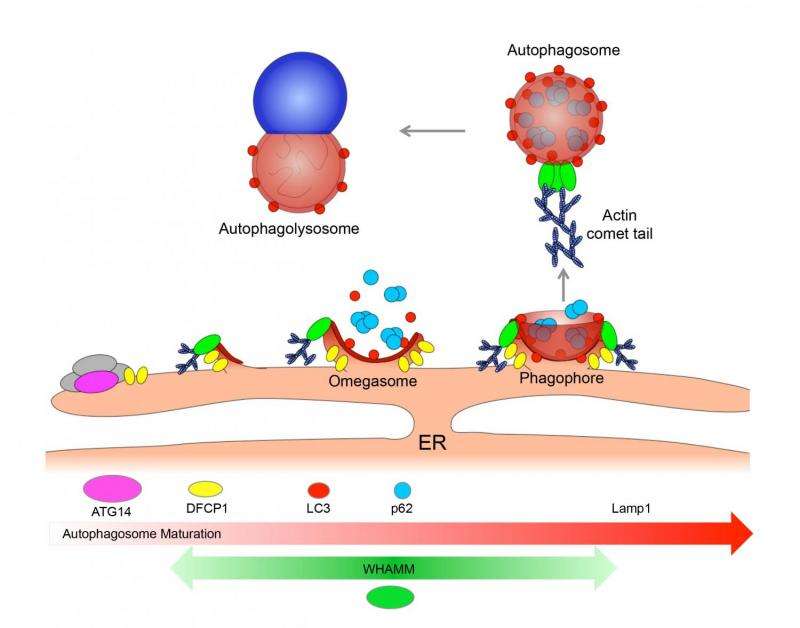Protein 'comet tails' propel cell recycling process

Several well-known neurodegenerative diseases, such as Lou Gehrig's (ALS), Parkinson's, Alzheimer's, and Huntington's disease, all result in part from a defect in autophagy - one way a cell removes and recycles misfolded proteins and pathogens. In a paper published this week in Current Biology, postdoctoral fellow David Kast, PhD, and professor Roberto Dominguez, PhD, and three other colleagues from the Department of Physiology at the Perelman School of Medicine at the University of Pennsylvania, show for the first time that the formation of ephemeral compartments key in this process require actin polymerization by the Arp2/3 complex, a composite of seven proteins.
They found that the cell recycling machinery is regulated by a protein called WHAMM, and that interfering with this protein or actin polymerization itself severely inhibits the cell's ability to recycle misfolded proteins and damaged organelles via autophagy. This is particularly important for non-dividing neurons, because the accumulation of waste leads to impaired intercellular communication and neurodegeneration.
"Cells are very good at recycling and sorting cellular trash into the correct recycling bins," Dominguez says. "Cells sequester trash in compartments called autophagosomes" Cells follow a set recipe for recycling: First, the autophagosome is formed around the trash, next autophagosomes are transported and merged with lysosomes - another cellular compartment - and finally, the contents are degraded and either secreted or reused by the cell.
The Penn team found that this recycling process is fueled by the actin cytoskeleton, whose major component is the protein actin itself. Autophagosomes arise from the endoplasmic reticulum (ER)—a network of tubular membranes - and actin dynamics is key in their formation and movement.
The "fuel" for the biogenesis and movement of autophagosomes is provided by actin polymerization powered by the Arp2/3 complex, which is recruited to autophagosomes by WHAMM. Polymerization is the chemical reaction that allows for the formation of molecular chains, in this case, actin filaments.
In cells, proteins that induce the polymerization of actin, such as the Arp2/3 complex, also control it. When the actin polymerization occurs at one spot on the surface of an autophagosome, which coincides with the location of WHAMM on these organelles, an actin comet tail is formed, and the rapid assembly/disassembly of the actin polymers "pushes" the autophagosome toward the lysosome for final processing. The Penn scientists have visualized this phenomenon at high resolution in live cells, revealing the formation of actin "comet tails" that propel the formation and movement of autophagosomes from the ER membrane. The constant assembling and disassembling of actin comet tails on the surface of autophagosomes makes them move with speeds of approximately 0.5 micrometers per second.
"Actin acts like rocket fuel to drive this process" Kast says. "Actin can function as a track for myosin, or as a motor on its own via this comet tail mechanism."
The team starved cells of amino acids to spur the formation of autophagosomes. But why did they home in on WHAMM as the connector in the first place? "Kind of by luck," says Kast. WHAMM was known to exist in the ER and Golgi apparatus, but we really didn't know what role it played. The Dominguez lab was first interested in WHAMM because of its role in the regulation of the Arp2/3 complex, the only branched-actin nucleating system in cells. On the other hand, autophagy was recently shown to involve actin, but the mechanism was unknown. The Penn scientists connected these observations and hypothesized that possibly WHAMM could link actin assembly to autophagy.
They showed that interfering with actin polymerization, knocking down WHAMM, or blocking its interaction with other proteins all inhibit actin "comet tail" formation and reduce the size and number of autophagosomes. These results reveal a link between actin-comet tail motility and autophagy. "Understanding the underlying mechanism for autophagosome formation and maturation will allow us to better understand the differences between the many neurodegenerative diseases that have been linked to defects in autophagy," Kast says.
Journal information: Current Biology
Provided by University of Pennsylvania School of Medicine



















